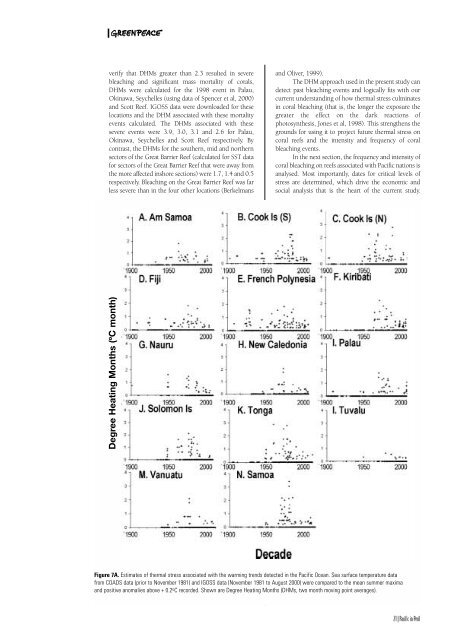Pacific in Peril - Greenpeace
Pacific in Peril - Greenpeace
Pacific in Peril - Greenpeace
Create successful ePaper yourself
Turn your PDF publications into a flip-book with our unique Google optimized e-Paper software.
verify that DHMs greater than 2.3 resulted <strong>in</strong> severe<br />
bleach<strong>in</strong>g and significant mass mortality of corals,<br />
DHMs were calculated for the 1998 event <strong>in</strong> Palau,<br />
Ok<strong>in</strong>awa, Seychelles (us<strong>in</strong>g data of Spencer et al, 2000)<br />
and Scott Reef. IGOSS data were downloaded for these<br />
locations and the DHM associated with these mortality<br />
events calculated. The DHMs associated with these<br />
severe events were 3.9, 3.0, 3.1 and 2.6 for Palau,<br />
Ok<strong>in</strong>awa, Seychelles and Scott Reef respectively. By<br />
contrast, the DHMs for the southern, mid and northern<br />
sectors of the Great Barrier Reef (calculated for SST data<br />
for sectors of the Great Barrier Reef that were away from<br />
the more affected <strong>in</strong>shore sections) were 1.7, 1.4 and 0.5<br />
respectively. Bleach<strong>in</strong>g on the Great Barrier Reef was far<br />
less severe than <strong>in</strong> the four other locations (Berkelmans<br />
Degree Heat<strong>in</strong>g Months (ºC month)<br />
and Oliver, 1999).<br />
The DHM approach used <strong>in</strong> the present study can<br />
detect past bleach<strong>in</strong>g events and logically fits with our<br />
current understand<strong>in</strong>g of how thermal stress culm<strong>in</strong>ates<br />
<strong>in</strong> coral bleach<strong>in</strong>g (that is, the longer the exposure the<br />
greater the effect on the dark reactions of<br />
photosynthesis, Jones et al, 1998). This strengthens the<br />
grounds for us<strong>in</strong>g it to project future thermal stress on<br />
coral reefs and the <strong>in</strong>tensity and frequency of coral<br />
bleach<strong>in</strong>g events.<br />
In the next section, the frequency and <strong>in</strong>tensity of<br />
coral bleach<strong>in</strong>g on reefs associated with <strong>Pacific</strong> nations is<br />
analysed. Most importantly, dates for critical levels of<br />
stress are determ<strong>in</strong>ed, which drive the economic and<br />
social analysis that is the heart of the current study.<br />
Figure 7A. Estimates of thermal stress associated with the warm<strong>in</strong>g trends detected <strong>in</strong> the <strong>Pacific</strong> Ocean. Sea surface temperature data<br />
from COADS data (prior to November 1981) and IGOSS data (November 1981 to August 2000) were compared to the mean summer maxima<br />
and positive anomalies above + 0.2 oC recorded. Shown are Degree Heat<strong>in</strong>g Months (DHMs, two month mov<strong>in</strong>g po<strong>in</strong>t averages).<br />
21 | <strong>Pacific</strong> <strong>in</strong> <strong>Peril</strong>


